Journalist Report – April 18th
[ Φύσις κρύπτεσθαι φιλεῖ ] Journalist Report
Crew 245 Journalist report 18 April 2022
Sol: 08
Name of person filling the report: Dr Benjamin Pothier
Days are becoming more and more packed here at the MDRS station. All the members of crew 245 want to conduct as many experiences and projects as they can while we are still living on Martian ground. From testing a helmet prototype to 3D printing in the RAM, and from 3D scanning rock formations around the station to making a 3D digital copy of the lower deck. It’s been a very busy day and we aren’t done yet as I have to participate with Luca in a neuroscience experiment involving a portable EEG headset before going to bed. We just had an amazing dinner with a main meal prepared by Nadia (Martian shepherd’s pie) and Luca is vacuum cleaning the upper deck as I type my report. These are chunks of our lives on Mars, like meteorites flashing in the sky, burning bright. A strange mix of the raw, the harsh, the mundane and the transcendent. As Heraclitus would say "Φύσις κρύπτεσθαι φιλεῖ" or "Nature loves to conceal herself", I do agree though yesterday’s night we managed to catch a bit of her : a night lapse of the station surrounded by the great Bear, the "Ursa Major" constellation. So yes, Nature loves to conceal herself, even on Mars, but like the Ursa Major we face events and remain constant.
—
Benjamin Pothier
The Explorers Club (NYC) International Fellow Member
PhD Researcher, CAIIA (Centre for Advanced Inquiry in Integrative Arts)
Planetary Collegium, Plymouth University.
https://www.plymouth.ac.uk/staff/benjamin-pothier
Crew Photos – April 18th
Hello please find attached the daily photos.
Bests regards, Crew journalist
Dr Benjamin Pothier
—
Benjamin Pothier
The Explorers Club (NYC) International Fellow Member
PhD Researcher, CAIIA (Centre for Advanced Inquiry in Integrative Arts)
Planetary Collegium, Plymouth University.
EVA Report – April 18th
Dear MDRS Support,
Please find below the Report for this afternoon EVA.
Best
Simone
"
Operations Report – April 18th
Dear MDRS Support,
I’m Luca Rossettini, Crew 245 Engineer. Please find here SOL 8 Operations
Report.
Best regards,
Luca
Sol Summary – April 18th
Hello CapCom,
Please find attached the Sol Summary.
Best regards,
Paolo GuardabassoSMOPS Crew Executive Officer
Science Report – April 17th
Crew 245 Mid-mission Research Report
– 3D Printed objects utility
Research objectives: The experiment aims to test various 3D-printed objects for EVAs (surface sampling activities, drone’s spare) and medical activities. Each 3D-printed material will be tested immediately after printing, then use during nominal operations. The raw material used for the experiment is polymers which offer similar mechanical properties as metals. After each use, fill out a questionnaire and pictures of the object to analyse the degradation of the object with the use.
Achieved so far: Successfully tested several geology tools for sample collections and storage. Crew 3D printed some of them before the mission but also during the missions.
– 3D Scan
Research objectives: The experiments aim to perform a detailed scan of the Habitat (internal and external) and generate a detailed 3D map of it. Potentially, other geological features might be scanned and mapped.
Achieved so far: The crew performed a scan of the internal part of the habitat and of a geological feature, but there are some issues in the post-processing of the data with the dedicated SW. The crew will get in touch by email with the HW provider to try to solve it
– Air Purification for Life Support systems
Research objectives:
The experiment focuses on three main parts or “sub-experiments”:
• Experiment 1: monitoring the quality of the air by measuring the degree of contamination (or particulate matter PM) carried by the crew members.
• Experiment 2: Bacteriological detector for the evaluation of the bacterial concentration.
• Experiment 3: Bacterial cultivation in a controlled environment.
Achieved so far: the air purifier has been installed in the crew quarters of the habitat and it was activated right after. In addition to the daily filtering routine, the crew performs every other day manual measurements with a separate device to compare the two measurements.
– Astrobiome
Research objectives: The purpose of this experiment is to test in the specific conditions of a mission at MDRS an elite level market microbiome health supplement developed by Mars City Design and Innovation Labo. According to the manufacturers, “ AlphaBiota P is a complex Super Probiotic.It contains Lactobacillus, a lactic acid bacteria complex formulation, with efficacy measured by clinical test; After 7 days, AlphaBiota results in some bodyweight loss of 2 lbs, liver health support by ALT reduction up to 25%, support heart, kidney, brain, blood cell by AST reduction up to 42%, increase bone and joint strength by ALP reduction up to 10%, reduce risk of diabetes by HOMA elimination up to 18%.
Achieved so far: Crew continues to take the daily supplement and it will soon start to record any changes in the bowel movements
– Biomonitors for continuous care
Research objectives:
The purpose of the experiment is to continuously monitor the health of the crew members through a biomonitor device that includes integrated sensors designed to measure the body activity, heart rate, and body temperature and pressure of the crew members.
The members will wear the biomonitor sensors under the suits.
The data collected from the body monitoring are processed through dedicated available software, and then transmitted to the university to be analyzed
Achieved so far: Crew continues to wear the sensors (on a T-shirt and headband) and the Crew HSO will check the correct transmission of the data and value from time to time. The crew will continue to wear them for the rest of the mission and data will be processed post-mission.
– BGM Mark 1 suits
Research objectives: Tests of the upper and lower part of a spacesuit simulator designed by Radici and shoes designed by Vibram and E-Novia group. These parts include sensors to measure quantities relevant for spacesuit simulator R&D. The lower part is interfacing with the provisory upper part and with the MDRS helmet and PLSS.
Through questionnaires, the comfort of planetary exploration will be assessed while a key success point is also the collection and transfer of data from the sensors. These sensors are TBD
This experiment is part of a larger program for the development of a spacesuit simulator for analogue missions. In the frame of the Mark 1 experiment, only the Lower Body Assembly (LBA) will be tested, leaving a provisory shirt to interface with the spacesuit simulator of the MDRS (composed of a backpack and helmet).
Achieved so far: Crew continues to wear the sensors (arm and shoes) during EVAs and the Crew Executive Officer downloads the data at the end of each EVA session. The crew will continue to wear them for the rest of the mission and data will be processed post-mission.
– Electroencephalogram
Research objectives: The purpose of this experiment consists of theoretical and practical study of the use of portable EEG headsets for neurofeedback experiments in isolated, confined, and extreme environments, and the use of VR goggles with meditation-related content and AO scan brain biomarkers for future long length space missions (LLSM). EEG results are compared with over 10,000 physiological biomarkers remotely extracted from AO Scan bioinformatics software. 52 Nerve Brain Biomarkers, 45 Brain Sagittal Biomarkers, 13 Cerebral Cortex Biomarkers for a total of 110+ Brain Biomarkers are generated with each AO Comprehensive Scan. With 30+ Comprehensive and Vitals Scans, data analysis may focus on comparison, efficacy, and accuracy of biomarkers out of balance (BOB) from EEG headsets, biomarkers from wearable, and biomarkers relevant to human spaceflight.
The study culminates in the first studies to use remote bioinformatics software to monitor brain biomarkers. The aim of the research is to inquire about the new non-intrusive methodology to countermeasure stress in isolation to enhance human performances in future long length space missions.
Achieved so far: Not yet performed, first session expected on the night of SOL7
– Evaluation of drone operations and questionnaires
Research objectives:
Mapping (1)* and inspection (3) of the station and its elements (e.g. solar arrays) during Extra-Vehicular Activities (EVAs), also simulating possible search and rescue (2) events.
Acquisition of the martian base camp outside environment monitoring sandstorms through a warning weathercast system (4).
For the scenarios, a VTOL (Vertical Take-Off Landing) drone is used for photogrammetry and surface analysis and exploration. The VTOL would also support the astronauts’ operations during the EVAs
Note: () Numbers indicate priority
Achieved so far: Crew performed a test for the mapping function and a first full mapping session on Sol7. The map will be used for the navigation test required for the Spit test experiment.
– Micrometeorites from the Solar System
Research objectives: The main purpose of the experiment is to find the extra-terrestrial materials on the earth’s surface through the search for micrometeorites in the analog field.
The crew will collect a minimum of 10 and maximum of 30 geological samples in different locations in the area of the Mars Research Desert Station that will be then analysed inside the station to search for micrometeorites.
All the samples will be stored and delivered to the PI after the mission.
Similar investigation and sample collection will be carried out in other analog environments (e.g. AMADEE20 performed by the Austrian Space Forum) and these different analog areas will be compared by extra-terrestrial traces. The final goal is to establish an analog mission micrometeorite archive.
Achieved so far: The crew collected already the minimum required number of samples (ten) and will continue to collect them until the end of the mission (if possible). In parallel, the collected samples will be analysed in the incoming days to search for microparticles of meteorites.
– Portable DNA analyser in search for Extraterrestrial life
Research objectives: This experiment aims to optimize research methods based on the restrictions of human-robotic exploration missions. Here, we focus on the easy-to-do methods including classical microbiology and NGS (next-generation sequencing) techniques to identify extremophile bacteria, archaea, tardigrades, and slime mold. During this mission, we aim to analyse sand samples on traces of microbial DNA. The experiment contains the following steps (1) sample collection; (2) DNA extraction; (3) sequencing, (4) analyses and interpretation (post-mission)
Achieved so far: The crew collected already the maximum required number of samples (ten) and they will be processed in the incoming days to extract the DNA to be sequenced by the portable device
– Satellite communication and data exchange
Research objectives: The purpose of the experiment is to measure the communications level between the GCS and the on-orbit satellite (D-orbit) through the amateur radiofrequency. The software tool required for the experiment is also provided by D-Orbit.
Achieved so far: The crew installed the antenna and the ground station, it also attempted to connect a few times with the satellite during its pass above the station but without success.
Troubleshooting activities will be performed in the incoming days
– Spit cortisol test
Research objectives: Measuring the cortisol level affecting the crew members. This test plays an important role in understanding (but also preventing) potential health risks, such as high blood pressure, high blood sugar, muscle weakness, etc. The test could be done through blood samples combined with cyclomatic tests for the crew.
Achieved so far: The collection of the samples for the cortisol tests will be performed in the next few days. The execution of the experiment was pending the successful execution of the drone mapping experiment.
Commander Report – April 17th
Crew 245 Commander Report 17th April 2022
SOL: 07
Name of person filing report: Vittorio Netti
It`s Easter on Mars! We are gonna celebrate with another round of local meals after two very challenging EVA for the whole crew. We received all the resupply missions from the Earth and all the experiments are running smoothly. Today we also tested a new compact helmet developed by Mars Planet technology. The wind slowed down allowing a new drone mapping mission. halfway through our mission, morale is high and we started processing the scientific data. We can`t wait to see the results of our tireless work. But today we celebrate.
Commander out,
Supplemental Operations Report – April 17th
Supplemental Operations Report 17 April 2022
Name of person filing report: Shannon Rupert
Reason for Report: Routine
Non-nominal systems: Water pump in outpost storage tank, Hab furnace
Action taken for non-nominal systems: Ordered new pump and hose to temporarily use for the remainder of this season and we can install a new permanent pump in the fall. I ordered the wrong thermostat for the furnace but am going to just retire it as we will be getting a new one in the fall and we just experienced probably the final cold weather of the season.
Generator: Still being manually run at night.
ScienceDome Dual Split: Off
Solar—Charge controllers off at night.
Solar— Nominal
Notes on power system: Nothing to report
Propane Reading, station tank – 58 %
Propane Reading, director tank— 50%
Propane Reading, intern tank— 69 %
Propane Reading, generator— 68 % (I think—I forgot between there and here!)
Ethanol Free Gasoline – 0 gallons.
Water (Outpost tank) – 350 gallons
Sojourner rover used: no
Hours: 167.7
Beginning charge: 100
Ending charge: 100
Currently charging: yes
Notes on rovers: Oppy is starting to overheat as it gets hot. I have moved it off campus for service and once I have done it, I will move it back for short and/or slow trips.
I’m all set up to service the rovers tomorrow. The batteries will be cleaned and neutralized, then the cells refilled with distilled water.
ATV’s Used: (Honda, 350.1, 350.2, 300): none
Reason for use: n/a
Oil Added? No.
ATV Fuel Used: 0 gallons
# Hours the ATVs were Used: 0 hoursNotes on ATVs: Nothing to report
HabCar used and why, where? Yes, to town for garbage and water
CrewCar used and why, where? Yes, to town for packages
Luna used and why, where? Yes, to town. I changed the cabin and regular air filters.
Campus-wide inspection, if action is taken, what and why? Things are holding up very well in the wind this year. We haven’t had many windstorms this season though, so that’s probably part of it. The Hab has gotten the worse of it and some of the outer walls have damage.
General notes and comments: There will not be a Supplemental Operations Report this Wednesday.
Summary of general operations: Nothing to report
Summary of internet: Nothing to report
Summary of suits and radios: Nothing to report
Summary of Hab operations: Nothing to report
Summary of Outpost operations: New toilet installed and working well. But then the pump in the now clean water storage tank stopped working. I moved the plants from the intern trailer to the ScienceDome.
Summary of GreenHab operations: The windstorms have deposited a lot of sand in the GreenHab.
Summary of ScienceDome operations: Nothing to report
Summary of RAM operations: Nothing to report
Summary of any observatory issues: Nothing to report
Summary of health and safety issues: Nothing to report
EVA Report #2 – April 17th
Crew 245 EVA Report 17-04-2022
SOL: 7
EVA #: 8
Author: Dr. Nadia Maarouf
Purpose of EVA: Samples collection for the geology, sample collection tool testing, and Helmet testing
Start time: 07:35
End time: 10:00
Narrative: Crew drove to Moon Overlook (zone D from the new map), the "Moon" from the old map, then (possibly) up to north Copernicus to zone A from the new map. we tested the new helmet and aborted the EVA due to a backpack malfunction (#3). We drove back to the hab fast but safe.
Destination: Moon Overlook
Coordinates (UTM NAD27 CONUS): 4254400 N, 516000 E
4256400 N, 517000 E
Participants: Nadia (Commander) Paolo (HSO). Luca and Benjamin
Road(s) and routes per MDRS Map: North on Cow Dung Road 0110 then Brahe Hwy1572 then Copernicus Hwy 0157
Mode of travel: Rover and Walking


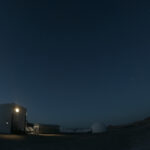
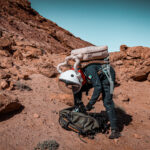
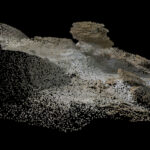
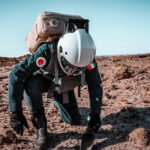
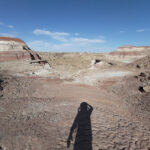
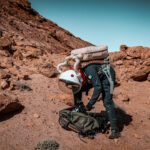
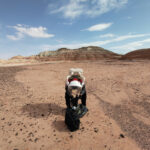
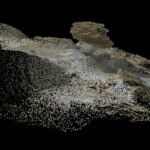
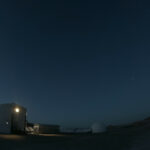
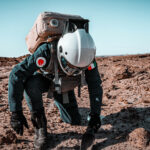
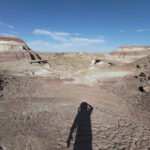
You must be logged in to post a comment.